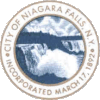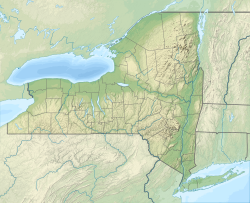
A | B | C | D | E | F | G | H | CH | I | J | K | L | M | N | O | P | Q | R | S | T | U | V | W | X | Y | Z | 0 | 1 | 2 | 3 | 4 | 5 | 6 | 7 | 8 | 9
Niagara Falls | |
|---|---|
City | |
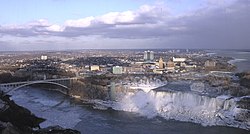 The city of Niagara Falls. In the foreground are the waterfalls known as the American Falls and Bridal Veil Falls, respectively, from left to right. | |
| Nickname(s): Niagara Falls USA Honeymoon Capital of the World | |
 Location in Niagara County and the state of New York. | |
| Coordinates: 43°6′N 79°1′W / 43.100°N 79.017°W | |
| Country | |
| State | |
| County | Niagara |
| Settled | 1679 |
| Incorporated as a city | March 17, 1892 |
| Government | |
| • Type | Strong mayor-council |
| • Mayor | Robert Restaino (D) |
| • City Administrator | Anthony Restaino |
| • City Council | Members' List |
| Area | |
| • City | 16.83 sq mi (43.58 km2) |
| • Land | 14.09 sq mi (36.48 km2) |
| • Water | 2.74 sq mi (7.10 km2) 16.37% |
| • Urban | 366.7 sq mi (949.7 km2) |
| Elevation | 614 ft (187 m) |
| Population (2020) | |
| • City | 48,671 |
| • Rank | NY: List of cities in New York (state) 34th (2010) |
| • Density | 3,455.27/sq mi (1,334.09/km2) |
| • Urban | 935,906 (US: 46th) |
| • Urban density | 2,663.5/sq mi (1,028.37/km2) |
| • Metro | 1,134,155 (US: 50th) |
| • CSA | 1,206,992 (US: 47th) |
| Time zone | UTC-5 (EST) |
| • Summer (DST) | UTC-4 (EDT) |
| ZIP codes | 14301-14305 |
| Area code | 716 |
| FIPS code | 36-51055 |
| GNIS feature ID | 0970406 |
| Demonym | Niagarian Niagara Fallsite |
| Website | niagarafallsusa |
Niagara Falls is a city in Niagara County, New York, United States. As of the 2020 census, the city had a total population of 48,671.[2] It is adjacent to the Niagara River, across from the city of Niagara Falls, Ontario, and named after the famed Niagara Falls which they share. The city is within the Buffalo–Niagara Falls metropolitan area and the Western New York region.
While the city was formerly inhabited by Native Americans, Europeans who migrated to the Niagara Falls in the mid-17th century began to open businesses and develop infrastructure. Later in the 18th and 19th centuries, scientists and businessmen began harnessing the power of the Niagara River for electricity and the city began to attract manufacturers and other businesses drawn by the promise of inexpensive hydroelectric power. After the 1960s, however, the city and region experienced an economic decline. As industries left the region, affluent and middle-class families relocated from Niagara Falls to other metropolitan areas around the country.
Due to the loss of jobs in the region, especially in the manufacturing sector, the city has gone from over 102,000 residents in 1960 to approximately 48,000 residents in 2020, a population drop of more than 50%.
History
Before Europeans entered the area, it was dominated by the Neutral Nation of Native Americans. European migration into the area began in the 17th century. The first recorded European to visit the area was Frenchman Robert de la Salle, who built Fort Conti at the mouth of the Niagara River early in 1679, with permission from the Iroquois, as a base for boatbuilding; his ship Le Griffon was built on the upper Niagara River at or near Cayuga Creek in the same year.[3] He was accompanied by Belgian priest Louis Hennepin, who was the first known European to see the falls. The influx of newcomers may have been a catalyst for already hostile native tribes to turn to open warfare in competition for the fur trade.
The City of Niagara Falls was incorporated on March 17, 1892, from the villages of Manchester and Suspension Bridge, which were parts of the Town of Niagara. Thomas Vincent Welch, a member of the charter committee and a New York state assemblyman and a second-generation Irish American, persuaded Governor Roswell P. Flower to sign the bill on St. Patrick's Day. George W. Wright was elected the first mayor of Niagara Falls.[4]
By the end of the 19th century, the city was heavily industrialized, due in part to the power potential offered by the Niagara River. Tourism was considered a secondary niche, while manufacturing of petrochemicals, abrasives, metallurgical products and other materials was the main producer of jobs and attracted a large number of workers, many of whom were immigrants.
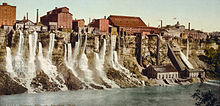
In 1927, the city annexed the village of La Salle, named for Robert de la Salle, from the Town of Niagara.
Industry and tourism grew steadily throughout the first half of the 20th century due to a high demand for industrial products and the increased mobility of people to travel. Paper, rubber, plastics, petrochemicals, carbon insulators and abrasives were among the city's major industries. This prosperity would end by the late 1960s as aging industrial plants moved to less expensive locations. In addition, the falls were incompatible with modern shipping technology.[further explanation needed]
In 1956, the Schoellkopf Power Plant on the lower river just downstream of the American Falls was critically damaged by the collapse of the Niagara Gorge wall above it. This prompted the planning and construction of one of the largest hydroelectric plants to be built in North America to that time, generating a large influx of workers and families to the area. New York City urban planner Robert Moses built the new power plant in nearby Lewiston, New York. Much of the power generated there fueled growing demands for power in downstate New York and New York City.
The neighborhood of Love Canal gained national media attention in 1978 when toxic waste contamination from a chemical landfill beneath it forced United States President Jimmy Carter to declare a state of emergency, the first such presidential declaration made for a non-natural disaster. Hundreds of residents were evacuated from the area, many of whom were ill because of exposure to chemical waste.[5]
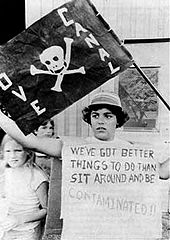
After the Love Canal disaster, the city—which had already been declining in population for nearly two decades—experienced accelerated economic and political difficulties. The costs of manufacturing elsewhere had become less expensive, which led to the closure of several factories. The city's population eventually dropped by more than half of its peak, as workers fled the city in search of jobs elsewhere. Then, much like the nearby city of Buffalo, the city's economy plummeted when a failed urban renewal project destroyed Falls Street and the tourist district.
In 2001, the leadership of Laborers Local 91 was found guilty of extortion, racketeering and other crimes following an exposé by Mike Hudson of the Niagara Falls Reporter. Union boss Michael "Butch" Quarcini died before trial, while the rest of the union leadership was sentenced to prison.
In early 2010, former Niagara Falls Mayor Vincenzo Anello was indicted on federal charges of corruption, alleging the mayor accepted $40,000 in loans from a businessman who was later awarded a no-bid lease on city property. The charges were dropped as part of a plea deal after Anello pleaded guilty to unrelated charges of pension fraud, regarding a pension from the International Brotherhood of Electrical Workers, of which he is a member. He was sentenced to 10 to 16 months in prison.[6]
The city's decline received national exposure from Bloomberg Businessweek in 2010.[7]
On November 30, 2010, the New York State Attorney General entered into an agreement with the city and its police department to create new policies to govern police practices in response to claims of excessive force and police misconduct. The city committed to create policies and procedures to prevent and respond to allegations of excessive force, and to ensure police are properly trained and complaints are properly investigated. Prior claims filed by residents will be evaluated by an independent panel.[8]
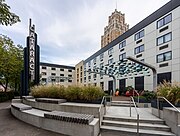
In 2020, a public square named Cataract Commons opened on Old Falls Street. It is a public space for outdoor events and activities.[9][10]
The city has multiple properties on the National Register of Historic Places.[11] It also has three national historic districts, including Chilton Avenue-Orchard Parkway Historic District, Deveaux School Historic District and the Park Place Historic District.
Geography
Niagara Falls is at the international boundary between the United States and Canada. The city is within the Buffalo–Niagara Falls metropolitan area and is approximately 16 miles (26 km) from Buffalo, New York.[12]
According to the United States Census Bureau, the city has an area of 16.8 square miles (44 km2), of which 14.1 square miles (37 km2) is land and 2.8 square miles (7.3 km2) (16.37%) is water.[13] The city is built along the Niagara Falls and the Niagara Gorge, which is next to the Niagara River.
Climate
Niagara Falls has a humid continental climate (Dfa). The city experiences cold, snowy winters and hot, humid summers. Precipitation is moderate and consistent in all seasons, falling equally or more as snow during the winter. The city has snowier than average winters compared to most cities in the US, however less than many other cities in Upstate New York including nearby Buffalo and Rochester. Thaw cycles with temperatures above 32 °F (0 °C) are a common occurrence.[14] The hottest and coldest temperatures recorded in the decade through 2015 were 97 °F (36 °C) in 2005 and −13 °F (−25 °C) in 2003, respectively.[15] 38% of warm season precipitation falls in the form of a thunderstorm.[16]
| Climate data for Niagara Falls International Airport (1991–2020 normals, extremes 1951–present) | |||||||||||||
|---|---|---|---|---|---|---|---|---|---|---|---|---|---|
| Month | Jan | Feb | Mar | Apr | May | Jun | Jul | Aug | Sep | Oct | Nov | Dec | Year |
| Record high °F (°C) | 65 (18) |
68 (20) |
81 (27) |
86 (30) |
93 (34) |
95 (35) |
97 (36) |
95 (35) |
96 (36) |
85 (29) |
80 (27) |
72 (22) |
97 (36) |
| Mean maximum °F (°C) | 54.1 (12.3) |
51.1 (10.6) |
64.5 (18.1) |
78.9 (26.1) |
85.8 (29.9) |
88.8 (31.6) |
91.3 (32.9) |
89.1 (31.7) |
87.0 (30.6) |
78.2 (25.7) |
66.4 (19.1) |
56.2 (13.4) |
92.3 (33.5) |
| Mean daily maximum °F (°C) | 31.5 (−0.3) |
32.7 (0.4) |
41.4 (5.2) |
54.5 (12.5) |
67.6 (19.8) |
76.3 (24.6) |
80.7 (27.1) |
79.1 (26.2) |
72.5 (22.5) |
59.5 (15.3) |
47.4 (8.6) |
36.7 (2.6) |
56.7 (13.7) |
| Daily mean °F (°C) | 24.2 (−4.3) |
25.0 (−3.9) |
33.0 (0.6) |
44.4 (6.9) |
56.6 (13.7) |
66.3 (19.1) |
71.0 (21.7) |
69.4 (20.8) |
62.3 (16.8) |
50.6 (10.3) |
39.7 (4.3) |
30.2 (−1.0) |
47.7 (8.7) |
| Mean daily minimum °F (°C) | 16.8 (−8.4) |
17.3 (−8.2) |
24.7 (−4.1) |
34.3 (1.3) |
45.7 (7.6) |
56.2 (13.4) |
61.2 (16.2) |
59.6 (15.3) |
52.2 (11.2) |
41.6 (5.3) |
31.9 (−0.1) |
23.7 (−4.6) |
38.8 (3.7) |
| Mean minimum °F (°C) | −1.3 (−18.5) |
−0.2 (−17.9) |
7.4 (−13.7) |
23.3 (−4.8) |
32.5 (0.3) |
44.6 (7.0) |
51.7 (10.9) |
50.2 (10.1) |
40.8 (4.9) |
28.7 (−1.8) |
18.9 (−7.3) |
8.4 (−13.1) |
−5.2 (−20.7) |
| Record low °F (°C) | −16 (−27) |
−13 (−25) |
−8 (−22) |
12 (−11) |
24 (−4) |
37 (3) |
46 (8) |
45 (7) |
30 (−1) |
23 (−5) |
−2 (−19) |
−4 (−20) |
−16 (−27) |
| Average precipitation inches (mm) | 2.27 (58) |
1.77 (45) |
2.12 (54) |
3.19 (81) |
3.03 (77) |
2.88 (73) |
3.37 (86) |
2.62 (67) |
3.27 (83) |
3.23 (82) |
2.78 (71) |
2.44 (62) |
32.97 (837) |
| Average precipitation days (≥ 0.01 in) | 15.0 | 12.5 | 12.1 | 13.4 | 12.8 | 11.6 | 11.5 | 10.5 | 10.8 | 15.3 | 12.6 | 15.5 | 153.6 |
| Source 1: NOAA[15] | |||||||||||||
| Source 2: National Weather Service[17] | |||||||||||||
| Climate data for Niagara Falls, New York (1991–2020 normals, extremes 1989–2019) | |||||||||||||
|---|---|---|---|---|---|---|---|---|---|---|---|---|---|
| Month | Jan | Feb | Mar | Apr | May | Jun | Jul | Aug | Sep | Oct | Nov | Dec | Year |
| Record high °F (°C) | 65 (18) |
70 (21) |
81 (27) |
93 (34) |
93 (34) |
95 (35) |
97 (36) |
95 (35) |
93 (34) |
85 (29) |
72 (22) |
72 (22) |
97 (36) |
| Mean daily maximum °F (°C) | 33.4 (0.8) |
34.5 (1.4) |
42.9 (6.1) |
55.8 (13.2) |
68.8 (20.4) |
77.6 (25.3) |
82.2 (27.9) |
80.4 (26.9) |
73.9 (23.3) |
61.2 (16.2) |
48.9 (9.4) |
38.5 (3.6) |
58.2 (14.6) |
| Daily mean °F (°C) | 26.0 (−3.3) |
26.7 (−2.9) |
34.4 (1.3) |
45.9 (7.7) |
58.3 (14.6) |
68.0 (20.0) |
72.8 (22.7) |
70.9 (21.6) |
63.7 (17.6) |
52.0 (11.1) |
41.2 (5.1) |
32.0 (0.0) |
49.3 (9.6) |
| Mean daily minimum °F (°C) | 18.6 (−7.4) |
18.8 (−7.3) |
26.0 (−3.3) |
36.0 (2.2) |
47.9 (8.8) |
58.3 (14.6) |
63.4 (17.4) |
61.4 (16.3) |
53.6 (12.0) |
42.8 (6.0) |
33.4 (0.8) |
25.4 (−3.7) |
40.5 (4.7) |
| Record low °F (°C) | −15 (−26) |
−13 (−25) |
−9 (−23) |
14 (−10) |
28 (−2) |
38 (3) |
44 (7) |
44 (7) |
26 (−3) |
24 (−4) |
7 (−14) |
−7 (−22) |
−15 (−26) |
| Average precipitation inches (mm) | 2.59 (66) |
2.10 (53) |
2.44 (62) |
3.10 (79) |
3.14 (80) |
2.99 (76) |
3.38 (86) |
2.80 (71) |
3.25 (83) |
3.27 (83) |
2.89 (73) |
2.76 (70) |
34.71 (882) |
| Average snowfall inches (cm) | 22.3 (57) |
16.3 (41) |
11.6 (29) |
2.2 (5.6) |
0.0 (0.0) |
0.0 (0.0) |
0.0 (0.0) |
0.0 (0.0) |
0.0 (0.0) |
0.2 (0.51) |
4.1 (10) |
15.7 (40) |
72.4 (184) |
| Average precipitation days (≥ 0.01 in) | 18.4 | 14.7 | 13.3 | 13.4 | 12.7 | 11.3 | 10.7 | 10.4 | 10.3 | 13.7 | 13.3 | 16.2 | 158.4 |
| Average snowy days (≥ 0.1 in) | 14.6 | 12.1 | 7.3 | 2.4 | 0.0 | 0.0 | 0.0 | 0.0 | 0.0 | 0.2 | 3.9 | 10.3 | Zdroj:https://en.wikipedia.org?pojem=Niagara_Falls,_New_York|


